The content of the article
By elephant we mean a majestic animal that is afraid of mice, but we will mention this below. The elephant is herbivorous in its natural features. It is found in natural conditions, reserves, parks. Animals perform in the circus and live in zoos, but there are also domesticated elephants. In today's article, we consider everything that affects these mammals. We also provide interesting facts in order to become more familiar with the largest animals.
Description
- These animals are rightfully considered giants among the self-similar, although there are essentially no similar mammals. Elephant in height reaches about 4 m., But there are also smaller individuals (2-3 m.). Each individual has a mass in the range of 3–7 tons. If we are talking about African mammals that settle in the savannah, they weigh up to 8 tons. The representatives of the family under discussion are famous for their thick-skinned, which is more than 2 cm. The skin covering the mighty body is pigmented in gray or brown and has wrinkles. Adult elephants are hardly covered with vegetation, while their cubs are born with bristles.
- The head has a large format, ears are considered a distinctive characteristic. They are twisted and long, wide, thick. The edges are thin, the base is sealed. Ears serve as a means to regulate heat metabolism. When the mammal begins to wave its ears, it cools. Elephants are famous for the fact that each of their legs is immediately endowed with a pair of kneecaps. Due to the physique, these animals are one of a kind, not having to jump. On the central part of the feet are pillows that are endowed with springy properties. Despite their weight, during the walk the animals practically do not make noise.
- However, special attention is still paid to the trunk. By it is meant a unique sensitive organ, which is a fusion of the upper lip and nose. The trunk consists of one hundred thousand muscle fibers and tendons, due to which it is endowed with special strength and flexibility. This body has a certain responsibility for the performance of certain tasks. An animal breathes through a trunk, feels, perceives, grabs food. Mammals also use the trunk to protect, water their own body with water, communicate and educate the younger generation.
- Special signs include the fact that elephants have tusks. They continue to grow throughout their entire life cycle. You can understand how much a particular individual is approximately years old by looking at powerful or not too large tusks. The tail is equal in length to the length of the hind legs. At its end there are hard hairs that help fight off flies and other insects. Individuals of the presented family have a specific voice. By the sounds they make, you can recognize a certain whisper, grunting, roaring, quacking, etc. In general, the voice is ambiguous.
- Separately, it makes sense to consider the ability of this animal to swim perfectly. A gorgeous swimmer hides beneath the gigantic body. Elephants love to swim, they also know how to move quickly. During running, the speed is 50 kilometers per hour, and on foot these massive mammals walk at a speed of 5 kilometers per hour. Studying the duration of existence, it should be noted that elephants are classified as centenarians. Their age can be 65 or more years.
Elephant species
- To date, several main varieties of these reptiles are known.The first are called Asian (Indian), the second - African, they are slightly larger than their counterparts. Also, individuals living in the African part can be divided into groups. Elephants living in the savannah are considered the largest. Forest representatives are smaller, they are called swamp or dwarf, preferring to live in the forests of tropical zones.
- These Asian and African individuals have similar and distinctive features. Earlier it was mentioned that in Africa elephants are larger by a couple of tons. Also, mammals of this type have tusks in all genders, while elephants from India (in females) do not have tusks. There are differences in the format of the case. The back of the body of Indian individuals is raised.
- In mammals that live in African countries, the ears are large. Also their trunk is thinner. A very important distinguishing feature lies in the domestication. So, for example, Indian elephants with the proper skill and desire will be able to tame, and African counterparts will never succumb to this. For this reason, it is individuals of the Asian type who often appear in circuses. They are still young in trusteeship with a person and learn the basics of tricks.
- Naturally, there are distinctive features at the genetic level. They tried to cross these species of proboscis animals, but could not obtain offspring. As for life expectancy, it all depends on the living conditions and other aspects. It is generally accepted that individuals of African descent exist longer.
Habitat
- From the above information, it can be understood that members of the family belonging to the African type live in the appropriate locality. They are common in various parts of Africa, be it Kenya, Senegal, Namibia, Sudan, Congo, etc. Individuals have taken root in Somalia and Zambia. However, most of the population is in protected areas, since poaching is developed in Africa. These mammals love savannahs, they avoid dense vegetation, preferring sparse terrain.
- As for the proboscis of the Indian type, respectively, they live in Asian countries. This includes Thailand, India, Malaysia, Laos, China, etc. These individuals prefer to live in tropical forests, they abandon desert sites and move to where you can partially hide from your eyes. Usually settle next to bamboo. Previously, these elephants inhabited a large part of Asia, but in the last decade, the number has declined sharply.
Life span
- In their natural environment, these mammals do not live as long as if they were domesticated. Also in zoos, conservation areas and other specialized areas, elephants last longer. Partly, this aspect is connected with the fact that in such places there are people who can take care of elephants and exclude diseases. And in the natural environment, the animal simply dies, because it cannot recover on its own.
- An important role is played by the variety of a particular individual. Individuals of the Asian type live about 65 years, long-livers reach 70 years, as well as Africans. However, the life span is reduced to 50 years if the Indian elephant does not live in captivity, but in the natural environment.
- Of course, one cannot fail to touch upon the correctness of care for this mammal. An elephant, exhausted by a disease that has no one to help, does not live long. Even the slightest damage to the legs can result in death. If a person looks after these giant animals, then the mammal will be easier to cope with the disease. In the natural environment, hunting is conducted on cubs of elephants or sick proboscis.
Nutrition
- An interesting feature of the animals of this family is considered to be that they spend most of their existence on the absorption of food. This process takes more than fifteen hours.With great appetite, representatives of the proboscis species absorb more than three hundred kilograms of food. Most of the diet is vegetation. Individuals lean on the grass, wild fruit trees, for example, eat apples with bananas. They even eat coffee, bark and foliage.
- Basic nutrition is quite varied and directly depends on the area in which a particular individual lives. Of course, these giants cannot ignore cultivated varieties. They come to plantations, eat corn, sweet potatoes and other crops. Food is obtained with the help of a trunk and tusks, elephants chew food with molars. They are replaced by new ones after grinding.
- As for feeding elephants in captivity, they are often given a huge amount of greenery and hay in the zoo. In addition, the presented individuals constantly regale themselves with various root crops, watermelons, bran, bananas and even bread.
- It is worth noting an interesting fact that in the wild, the animals in question eat about 300 kg per day. products. At the same time, they make up a special diet in the zoo. The elephant is given only 30 kg. hay, 10 kg. vegetables and the same amount of bread.
- Do not forget that huge mammals love water and consume it in large quantities. Therefore, an adult requires about 250 liters per day. water. It is for the same reason that elephants almost always try to stay close to water bodies.
Breeding
- In free conditions, such animals are most likely to form family herds. In this case, there are about 10-12 individuals. In such a family, a mature leader is necessarily present. There will also be her sisters, daughters and immature males.
- It is the female in the elephant family that is the hierarchical link. She reaches puberty by only 12 years. At about 16 years old, she becomes ready for gestation. When males reach puberty, they leave the herd. This happens when he turns 15 to 20 years old.
- As a result, they begin to lead a solitary lifestyle. Every year, males become aggressive. This is due to a surge in testosterone. This condition persists for 2 months. In the course of this, serious battles often take place between clans. They always end with injuries and injuries.
- It is worth noting that even in such brawls there are advantages. Experienced brethren stop young elephants from mating at an early age. Young animals are simply not ready for adulthood. Therefore, competition should be.
- Surprisingly, the seasonality of the weather does not affect the reproduction of the individual in any way. In the mating season, the male approaches the herd as soon as he feels that the female is ready for mating. In normal times, males are loyal to each other.
- However, during the breeding season, they arrange mating fights among themselves. Only the winner will be able to approach the female. It is also noteworthy that the pregnancy in the female lasts about 20 months. After that, she creates her own society, in which she is preparing for childbirth.
- Other females try to protect the woman in labor from various dangers. Often, a baby elephant weighing about 100 kg is born. Only in rare cases do females give birth to twins. After only 2 hours, he can already get on his feet and move independently. The baby is immediately absorbed into breast milk.
- Literally in a few days, the baby can already fully travel along with adults. In order not to get lost, he grabs his mother’s tail with his trunk. Feeding lasts up to 2 years. Moreover, all the females who produce milk are often involved in the process. From the age of six months, the baby begins to try food of plant origin.
Elephants and mice
- Many people know that these individuals are very afraid of mice, but not everyone knows what this is connected with.This can be considered a myth rather than the truth. There is an ancient legend that a huge number of mice attacked elephants in ancient times.
- During this, rodents nibbled the feet of the giants almost to the bone. In addition, mice made holes in the flesh of elephants. It is for the same reason that giants are now sleeping not lying, but standing. However, if you think logically, many animals sleep in this position.
- For example, horses are standing asleep, but they do not feel a drop of fear for rodents. We can only assume that if the elephant rests resting, the mouse can crawl into his trunk. The rodent will simply block its access to oxygen and the giant will suffocate. Moreover, such cases were recorded several times.
- In addition to this, there is another theory, and it is rather ridiculous. Mice allegedly crawl onto the giant and tickle his skin strongly due to tenacious paws. For this reason, the elephant constantly wants to itch, but to make it extremely difficult for him.
- Fortunately, all such myths, legends and assumptions were debunked by scientists in the modern world. Elephants are absolutely indifferent to rodents. They even live peacefully with them in zoos and aviaries. Giants even allow them to feast on their leftover food. Therefore, hostility is out of the question.
Why do elephants have a nose in the form of a trunk
- It is because of the trunk that elephants are different from all other animals. It can be considered that this is the most spectacular part of the body. The trunk of an adult can grow up to 1.5 m in length. At the same time, its weight can reach about 150 kg. It is worth noting that such a part of the body is simply necessary for the giant. This can be compared to how a person needs hands, tongue or nose.
- It is surprising that the ancient ancestors of elephants lived in swamps, while the trunk was very small and was a process. Thanks to him, animals breathed when they were under the water. In the course of evolution, which lasted millions of years, from ancient descendants, animals turned into giant elephants with a long trunk. This happened due to adaptation to new conditions.
- Thanks to the trunk, elephants easily move heavy objects, if they need it. Also, the animal can get its own juicy fruits from palm trees. With a trunk, elephants collect water from ponds to get drunk or to make a shower when there is unbearable heat. Surprisingly, elephants learn to wield their trunk from an early age. These skills are taught to adults.
Elephants are rightfully considered unique animals. They are centenarians. Among the individuals there are also righties and lefties. Such features are not characteristic of animals. Giants communicate with each other at very low frequencies. They have a unique structure for a hearing aid. Elephants are able to hear each other at a great distance.
Video: elephant (Elephas maximus)

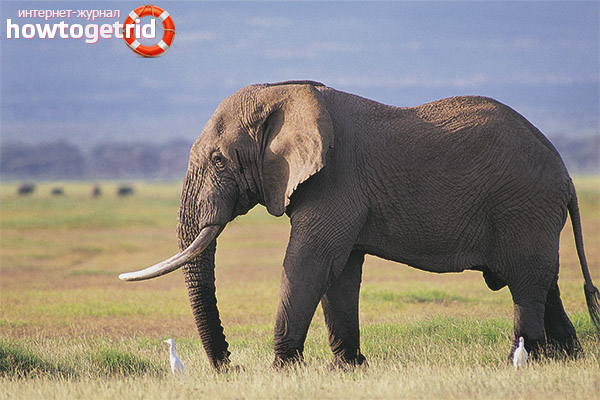
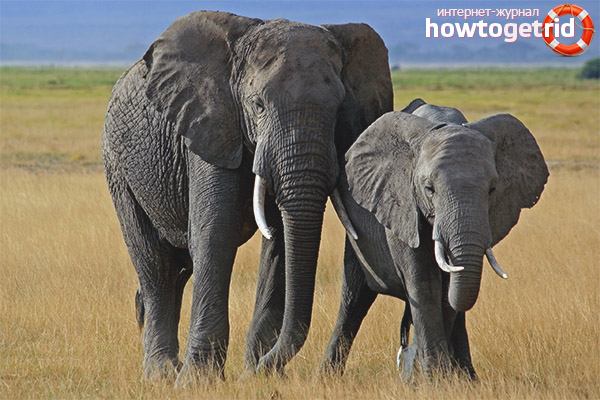
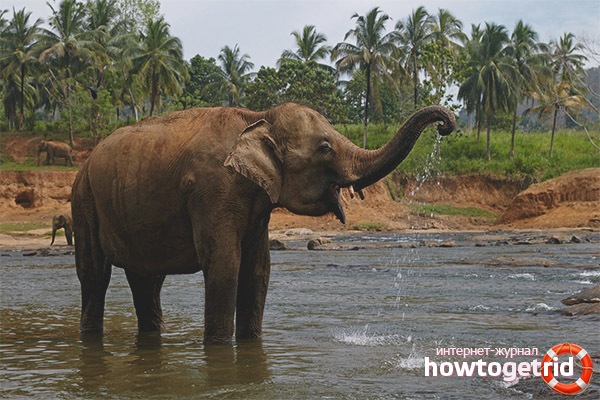
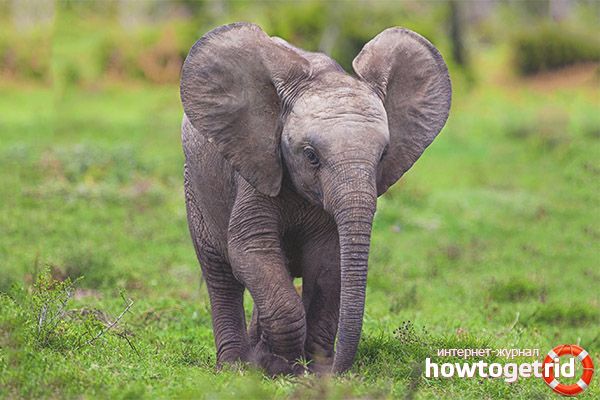
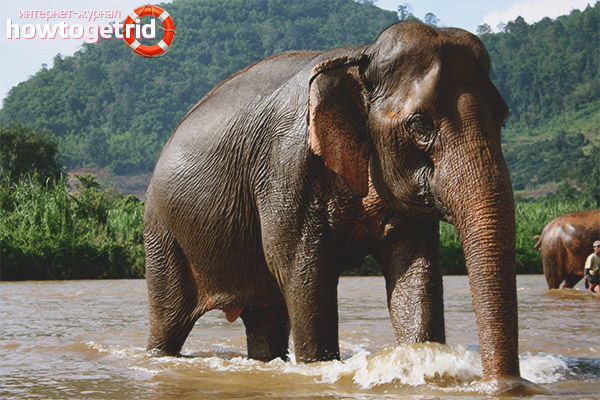








Submit